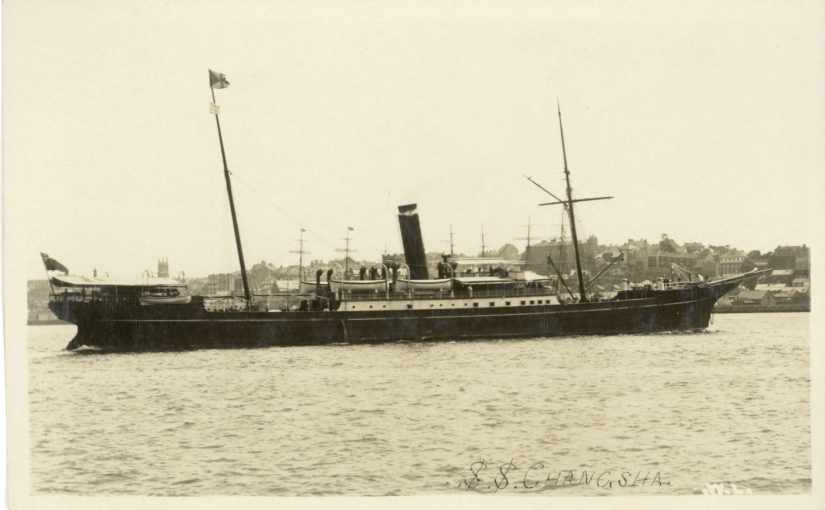Gathering some initial data after the transcribe-a-thon gave the Exploring Digital Heritage class several things to consider. What could we infer from the documents we, and many of you, had helped to transcribe? After looking at the data on ships and destinations, I decided to delve into the journeys those caught in the White Australia Policy took. Where were they going, what might travel have been like for them and what about the ships themselves?
The data collected so far indicates a distinct travel destination. Individuals found in the transcribed documents were mainly traveling to China. They departed from various ports along the East coast of Australia (The Australasian, 1909) with Sydney being a common departure point and Canton, China a frequent disembarkation. However, some travelled to India, Fiji, Syria, Japan and even France (fig. 1).

Traveling by ship during the period of the White Australia Policy was different from ocean travel today. The Aldenham and Australian were in service as early as the 1890s (Hoskin, E&A Line, 2007) and not near the size of modern passenger vessels. Unlike the current dedicated, entertainment focused, diesel or gas turbine powered ships; they travelled on passenger-cargo vessels mainly driven by steam. These included the Empire, Eastern, Australian and Aldenham (fig. 2) (Hoskin, E&A Line, 2007).

Some of the earlier built, the Taiyuan and Changsha (fig. 3) for example, were combined steam and clipper ships (Hoskin, Minor Shipping Lines and Ship Owners, 2017).

From the initial data it appears the Empire and Eastern were the most common ships/line to travel on followed by the Australian and Aldenham. A significant number of other ships also carried passengers during this time (fig. 4), allowing many individuals the means to travel to and from Australia.

The speed of travel ranged from 12 to 15 knots (Hoskin, E&A Line, 2007), about half the speed of today’s passenger liners. They docked at various points along the way. Stops differed according to the destination route but some docked at places such as Timor, the Dutch Islands, Hong Kong and Singapore (The Argus, 1911).
Besides travellers, the ships carried a considerable amount of freight. Cargo included animal products. Cattle for example were shipped to places like Thursday Island on the Changsha (The Northern Herald, 1921). Hundreds of “hindquarters of frozen beef” dispatched from Port Alma for Manila, Philippine Islands, and tens of “cases of preserved meats” headed for Darwin were both listed as cargo on the Empire (Morning Bulletin, 1915).
Further research into the ships found in the documents also gleaned interesting stories of their own. The Australian was wrecked off the Coburg Peninsula (Hoskin, E&A Line, 2007). During the war years the Changte and Taiping were requisitioned as stores ships (Flotilla Australia, Minor Shipping Lines and Ship Owners, 2007). Others, such as the Tiayuan and Aldenham carried soldiers (The Borella Ride, 2017), while the Eastern and Nellore, were destroyed when bombed and torpedoed respectively (Hoskin, E&A Line, 2007).
Overall, it appears ship travel was a curious adventure. Perhaps an adventure not unlike our class work. Document transcription has led to several avenues of research and is giving us a better idea of what was happening during this period. What more might we be able to find out about the people and the journeys they embarked on as we continue to transcribe and get a better overall picture. Hopefully, with further transcription, we can do just that.
Take a few moments and transcribe a document today. Help us continue to see these documents in different and enlightening ways.
References
Hoskin, J. (2007). Minor Shipping Lines and Ship Owners. [website] Available at: http://www.flotilla-australia.com/nsw-other.htm#taiping-yuill Accessed 19 Oct 2017.
Hoskin, J. (2007). E & A Line. [website] Available at https://www.flotilla-australia.com/eanda.htm Accessed 19 Oct 2017.
Morning Bulletin. (1915). ‘SS. EMPIRE.’, Morning Bulletin (Rockhampton, Qld. : 1878 – 1954), 8 June, p. 11. Available at: http://trove.nla.gov.au/newspaper/article/53366109?searchTerm=SS%20Empire&searchLimits Accessed 24 Oct 2017.
The Argus. (1911). ‘S.S. ALDENHAM.’, The Argus (Melbourne, Vic. : 1848 – 1957), 19 April, p. 6. Available at: http://trove.nla.gov.au/newspaper/article/10895637?searchTerm=S.S.%20Aldenham&searchLimits Accessed 22 Oct 2017.
The Australasian. (1909). ‘S.S. ALDENHAM.’, The Australasian (Melbourne, Vic. : 1864 – 1946), 27 November, p. 48. Available at: http://trove.nla.gov.au/newspaper/article/139216160?searchTerm=S.S.%20Aldenham&searchLimits Accessed 20 Oct 2017.
The Borella Ride. [website] Available at: http://theborellaride.com.au/ship/ Accessed 19 Oct 2017.
The Northern Herald. (1921). ‘The Changsha.’, The Northern Herald (Cairns, Qld. : 1913 – 1939), 9 November, p. 4. Available at: http://trove.nla.gov.au/newspaper/article/148047306?searchTerm=Changsha&searchLimits Accessed 20 Oct 2017.
Figures
Fig 1 & 4: Created from transcribed data
Fig 2: Aldenham (merchant ship). State Library New South Wales. Available at: http://digital.sl.nsw.gov.au/delivery/DeliveryManagerServlet?dps_pid=FL1144290&embedded=true&toolbar=false
Fig 3: Changsha (merchant ship). State Library New South Wales. Available at: http://digital.sl.nsw.gov.au/delivery/DeliveryManagerServlet?dps_pid=FL1644601&embedded=true&toolbar=false

